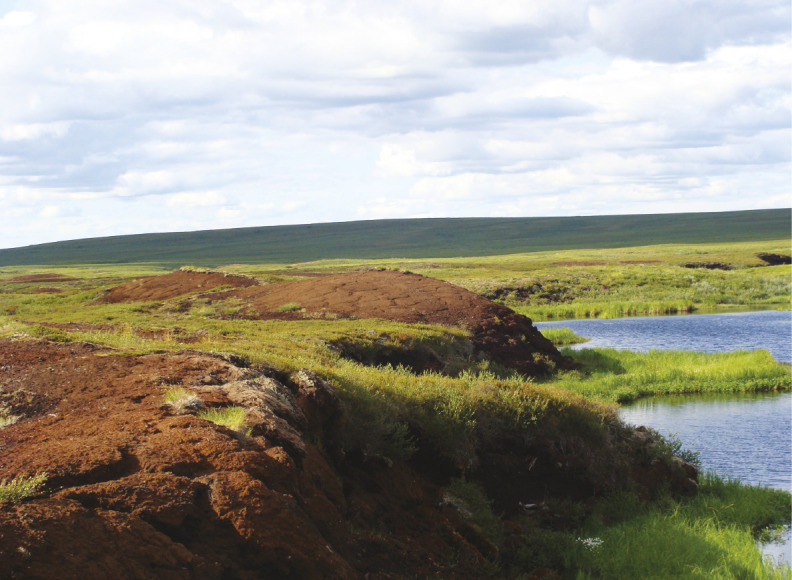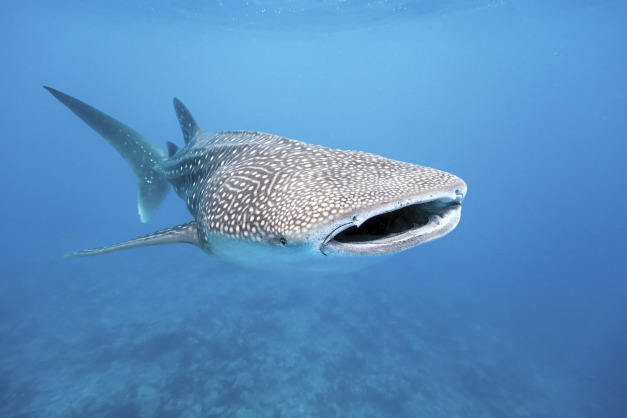Whale shark genome reveals insights into life span
Whale shark. Image credit: iStock/crisod.
The whale shark (Rhincodon typus), an endangered species and the largest living fish, can grow to a length of 20 m, weigh up to 42 tons, and live to an estimated 80 years. Jessica Weber, Seung Gu Park, Victor Luria, et al. (pp. 20662–20671) sequenced the whale shark genome and compared the sequence with those of 84 other eukaryotic species, from yeast to humans. Around half of the whale shark’s 3.2-Gb genome was composed of transposable elements, and the authors identified 28,483 predicted protein-coding genes. The genome was peppered with relatively long introns—noncoding sequences interspersed throughout the genome—that carried several types of repetitive DNA elements. Analysis of the evolutionary history of the whale shark’s slowly evolving genome revealed that around 58% of the genes are likely older than 684 million years, whereas nearly 35% of the genes arose in the last 93 million years, simultaneously indicating the genome’s degree of conservation and innovative potential. Additionally, neural genes, including those involved in neural connectivity, ion channels, and neurodegeneration, were markedly elongated in the whale shark genome; comparative analysis across multiple species revealed that in long-lived species neural genes tended to be longer than average genes. According to the authors, the study uncovers genomic features—notably the size of genes and, particularly, neural genes—tied to increased life span not only in whale sharks but across an array of species. — P.N.
Visualizing mitochondrial proteins at nanometer 3D resolution

3D MINFLUX image of mitochondrial proteins (MIC 60 in orange and F1Fo-ATP Synthase in blue).
The protein complex mitochondrial contact site and cristae organizing system (MICOS) is essential for maintaining the mitochondrial inner membrane and cristae architecture. MICOS consists of two subcomplexes and seven subunits and is enriched at crista junctions, but precisely how the subunits are distributed is unclear. Jasmin Pape, Till Stephan, et al. (pp. 20607–20614) used a technique called MINFLUX nanoscopy, which targets individually activated fluorophores with a doughnut-shaped excitation beam, and an analysis framework to investigate the distribution of three MICOS subunits—Mic60, Mic10, and Mic19—at single-digit nanometer precision in three dimensions. MINFLUX recordings suggested a ring-like arrangement of multiple Mic60 proteins, with a diameter of 40–50 nm, around individual crista junctions. Statistical analysis of dual-color MINFLUX images showed that Mic19 was close to Mic60 and had a more defined spatial relationship to it compared with Mic10, the relative localization of which to Mic60 was variable. This finding is consistent with Mic19 and Mic60 being part of the same MICOS subcomplex and indicates that MICOS has structural heterogeneity. According to the authors, MINFLUX nanoscopy, combined with an appropriate analysis framework, could serve as a useful tool for studying the localization of proteins within dense complexes with nanometer precision. — S.R.
Peatland carbon and nitrogen stocks and permafrost thaw

Eroding edge of permafrost peat plateau, Seida, western Russian Arctic.
Northern peatlands hold large stocks of carbon and nitrogen and thus play a key role in global climate dynamics. However, the vulnerability of peatlands to climate warming is uncertain, partly because of a lack of spatially explicit, observation-based peatland maps. Gustaf Hugelius et al. (pp. 20438–20446) generated maps of Northern Hemisphere peatland depth and carbon and nitrogen stocks using data compiled from more than 7,000 field observations. Based on the maps, the authors estimated that northern peatlands cover approximately 3.7 million km2 and store approximately 415 Pg of carbon and 10 Pg of nitrogen. A substantial portion of the carbon and nitrogen stocks are found in peatlands affected by permafrost. The authors estimated that, at present, northern peatlands are a net sink of atmospheric carbon. However, under future global warming scenarios, the authors projected losses of half to nearly all of peatland permafrost. This permafrost thaw would convert the peatlands to a net source of atmospheric carbon, primarily owing to increased methane emissions. According to the authors, the results suggest that although northern peatlands are currently a source of global cooling, permafrost thaw attributable to anthropogenic climate warming may convert peatlands into a net source of warming. — B.D.
How cyanobacteria tune their circadian period
Circadian clocks enhance fitness by aligning the biological rhythms of organisms with Earth’s daily cycle. Mutant organisms with extremely short or long circadian periods have been generated, but the mechanisms that tune the circadian period have remained unclear. Kumiko Ito-Miwa et al. (pp. 20926–20931) examined circadian regulation in cyanobacteria, which have a simple circadian clock consisting of only three clock proteins. The authors analyzed in vitro phosphorylation rhythms and in vivo bioluminescence rhythms of clock mutants. Mutations affecting the amino acid residue at position 402 of a circadian pacemaker protein called KaiC resulted in circadian periods that spanned an order of magnitude ranging from approximately half a day to nearly 1 week, which is much longer than the 2.5 days previously reported for cyanobacterial clock mutants. In particular, smaller volumes of residue 402 of KaiC were associated with longer circadian periods. Taken together, the findings provide clues to the mechanism within KaiC for tuning the circadian period. According to the authors, this mechanism could explain how cyanobacteria have successfully adapted to the Earth’s daily cycle. — J.W.
Blood biomarkers reveal aging differences among dolphins
Aging is associated with the development of chronic diseases. Insights into biological factors that influence aging have been limited due to methodological shortfalls, such as uncontrolled environmental factors, infrequent sampling in human studies, and the use of short-lived animals that may not recapitulate human aging. Stephanie Venn-Watson et al. (pp. 20950–20958) searched for aging biomarkers in a well-controlled cohort of bottlenose dolphins, which are long-lived mammals that experience similar age-related conditions to humans. From 1994 through 2018, the authors collected 5,889 routine blood samples from 144 0- to 54-year-old US Navy dolphins, all of which shared the same diet, healthcare, and environment. Of the 44 candidate aging biomarkers analyzed, significant age-related declines were observed for four biomarkers: hemoglobin (an iron-containing, oxygen-transport protein in red blood cells), alkaline phosphatase (an enzyme that may indicate liver or bone disease), platelets (cells involved in blood clotting), and immune cells called lymphocytes. Dolphins that displayed faster age-related declines in hemoglobin and lymphocytes were more likely to develop anemia and lymphopenia, which are conditions associated with aging in humans. According to the authors, the identification of aging-rate variation in subsets of dolphins could lead to the development of strategies to slow the progression of aging and prevent chronic diseases in humans. — J.W.
Deforestation and indigenous property rights
The Amazon rainforest influences Earth’s climatic and hydrological cycles. However, the Amazon, which is primarily located in Brazil, has experienced high levels of deforestation in recent years. By combining data on homologation, which refers to the granting of full property rights, with forest and vegetation cover data collected between 1982 and 2016, Kathryn Baragwanath and Ella Bayi (pp. 20495–20502) examined whether collective property rights granted to indigenous territories located in the Amazon rainforest led to a reduction in deforestation. By 1985, most indigenous territories had not been homologated, but by 1995 approximately half of territories had received full property rights. Territories granted full property rights exhibited a significant decrease in deforestation, but the effect did not extend to territories waiting to obtain full property rights through homologation. Furthermore, the granting of full property rights resulted in an up to 66% decrease in deforestation at the border of the territories. The findings suggest that granting property rights to indigenous territories is an effective method of preserving forested areas because it allows indigenous people to protect land from external threats, according to the authors. — M.S.
Air pollution and honey bee health
Air pollution is associated with a variety of health conditions in humans, but the effects on wild plants and animals are unclear. To identify factors that affect the health of pollinators such as bees, which play a critical role in global crop productivity and food security but have experienced dramatic declines worldwide, Geetha Thimmegowda et al. (pp. 20653–20661) sampled 1,820 Giant Asian honey bees over a three-year period across four sites in the city of Bangalore in India, a country with staggering levels of air pollution that is also a major producer of fruits and vegetables. Bees collected at sites with comparatively higher levels of air pollution showed lower survival rates as well as alterations in flower visitation, heart rate, and blood cell counts. Moreover, analysis of bees’ antennae and heart tissue showed that air pollution is associated with an increase in the expression of genes involved in stress, lipid metabolism, and immunity. Together, the findings suggest that air pollution may harm both insect health and ecosystem services. According to the authors, further studies are needed to accurately assess the impact of air pollution on the natural world and to shape international air quality guidelines. — J.W.



